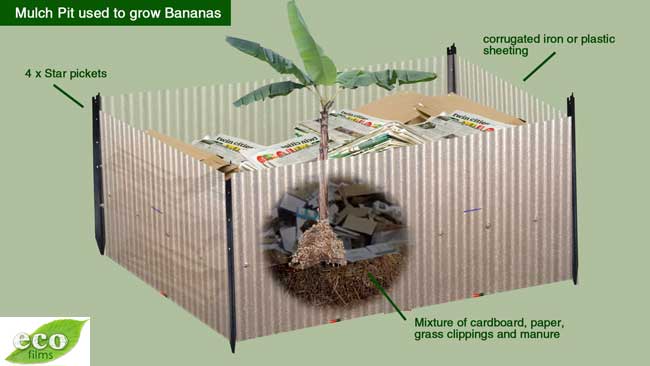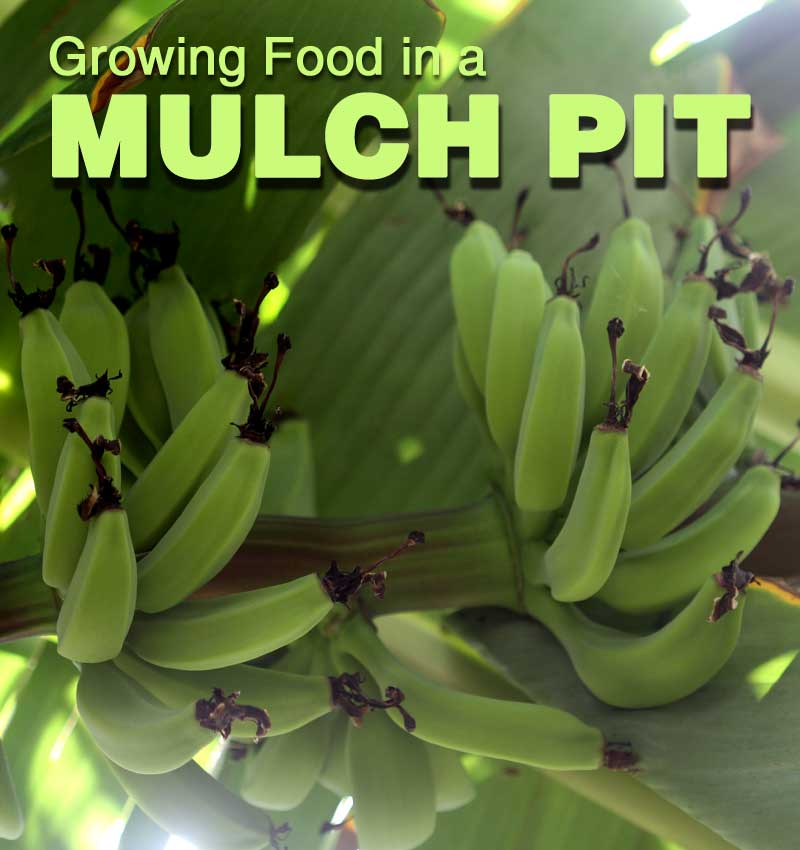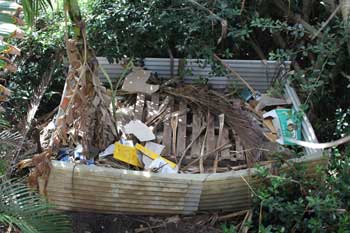Growing Food in a Mulch Pit
The idea of growing food in a mulch pit is something we came across whilst filming Geoff Lawton’s Introduction to Permaculture Design DVD. Geoff was climbing over what looked like a mountain of trash. Cardboard boxes, newspaper, old clothes and tree prunings. The mulch pit stretched over 20 to 30 feet and growing in the middle were a bunch of bananas. We decided to do something similar but weren’t too sure if it would work. Being in a sub tropical zone, our banana plant would also be planted in a more manageable backyard mulch pit that would be deep enough to contain many layers of mulch but protected from the wind and shaded by a large pandanus tree. My wife always wanted a Banana circle but given our soil condition it was always a difficult thing to do.
We live on very poor sandy soil so planting bananas directly into low nutrient sand was a no-no. We decided our bananas would be planted in the center of a similar pile of rubbish – a mulch pit. We hammered our 4 star pickets and used some old recycled corrugated skylight roofing to act as our frame to keep all the matter in place.
 “Bananas love lots of nutrients and water”
“Bananas love lots of nutrients and water”
Filling a pit of this size proved to be difficult at first as you will need a lot of carbon to fill a pit of this size. The grass clippings went into the pit. Tree branches. Anything we could find.
We ended up just having enough cardboard, old newspapers, straw and chicken manure to lay out a mulch trench a foot or so deep. This was enough to plant out some potatoes in the first year. The potatoes grew well and so did some cherry tomatoes.
You will need some patience with a mulch pit as things take a while to break down. But break down they will – transforming the layers into a rich mixture of organic matter and thriving micro-organisms.
After a while any mulch you lay will slowly decay and settle down and the height will reduce somewhat.
This was fine because over the months you’ll be surprised how much cardboard stuff you accumulate. It became a bottomless pit.
Christmas wrapping paper, beer cartoons, junk mail and anything that will break down went into this pit. Out garbage bins got lighter. To stop paper blowing away, we ended up throwing the bottom of a large timber pallet into the pit to keep everything in place.
Watering the mulch pit occasionally is a good idea as well. Any moisture captured will help rot down the carbon a lot faster and keep the base cool and damp.
Introducing a banana plant was just a matter of digging a hole into the cardboard layers and burying it with a little compost and watering the whole thing some more. The banana was not planted at ground level and would receive all its nutrients from the surrounding layers of rotting cardboard mulch – well that was the idea!
Now it was just a matter of waiting to see if the banana plant would grow? Over the months this plant seemed to do well as it produced one leaf after another. But would we get any bananas? I was told that bananas require a lot of moisture and love rich nutrients. Lots of nutrients, so keep piling them on. You can’t have enough. Our chicken coop was nearby so their manure also went into the mulch pit. Nothing was turned. It was all left to break down naturally.
“Would this mulch pit deliver the goods?”
We eventually forgot about it until last week. I looked up into the top of the tree and immediately noticed a brace of small green ladyfinger bananas. They looked perfect. I snapped off the photo you see above! How easy is this permaculture stuff I thought!
Now a mulch pit is probably not for everybody.
Its best to have it hidden behind a clump of bushes as we have done because – its not the most aesthetically handsome thing you’ll see for a while.
The idea is to eventually remove the pickets and the frame when the mulch breaks down and rebuild the pit somewhere else in the garden.
This way you keep making soil from stuff that would throw away anyway. It would all end up going into landfill.
You also get the bonus of growing your own food.
Although this process is used in a sub-tropical garden, I’m sure it would also work in other cooler zones with other fruiting plants and nut trees. All you are doing is adding high quality nutrients back into the soil and recycling carbon.
Oh, and our banana tree is now suckering a new little plant – so just maybe – we may get that banana circle after all!








Never heard of a mulch pit, but you describe it as we do at the end of the article, a banana circle!
Here we put all kinds of stuff, fish heads, dried horse manure, newspapers, cardboard boxes, yard trimmings.
I even know folks who connect discharge pipes all the way to their banana circle from their washing machine! Phosphates?
Fascinating ~ Is there any waste product that is detrimental to the plant growing?